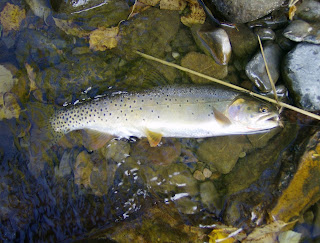The fly angler's secret for fishing small creeks and streams
Web Tease: When the large rivers are flowing high and murky, don't overlook small streams and creeks to satisfy your desire to go fly fishing. While the location of these streams may be secret, the rewards of fishing them are well known!

THE GREAT OUTDOORS — Because Utah is a dry, desert state, most of our large rivers receive moderate to heavy fishing pressure, especially in the summer and fall months.
Guides and outfitters work these waters, along with groups of fly fishers who enjoy the social aspects of angling. This increase in pressure can make it difficult for some to find a stretch of water all their own. Fishing pressure will send some fly fishers in search of their own piece of heaven: usually a small creek or stream that is often overlooked.
Many fly fishers have a secret creek or stream they rarely, if ever, share with others. They may talk about it, but never tell the location or name of the water. Some will give this water a code name or use the generic "No Tellum" creek as they verbally share their fishing experiences. This creek or stream is the one they fish alone, the place they go for solitude, the place they keep secret because too much pressure can send the already skittish trout into hiding, and because frankly, there is not enough room for a lot of anglers.
However, before you head out into the mountains to find your new favorite spring to fish this spring, be sure to read the proclamation and know which tributaries close for cutthroat trout spawning. Some tributaries close until the second weekend in July.
A fly fisher who takes the time to go exploring can find some real jewels. The old cliche "beauty is in the eye of the beholder" certainly applies to the perception fly fishers have on the waters they fish.
Here are some of the benefits of finding your own secret fishing stream.

Quantity
Many of Utah's small streams and creeks are teeming with trout. A fly angler who just wants to have a lot of fun catching fish will have a blast on small streams. A sneaky fly fisher with the skill to stalk and cast in tight brushy places should have no problem with numbers. It is possible to catch and release dozens of trout in a few hours on many of Utah's small streams. The trout in small streams are aggressive and opportunistic feeders and will hit most well-placed flies.
Quality
Some anglers measure quality in numbers, some measure quality in inches, while others measure quality in beauty. There are small creeks in Utah that have trout of decent size. While most trout will fall within the 6- to 12-inch range, it is possible to catch 14- to 19-inch trout in small waters. It is surprising to see a 19-inch trout come out of a deep undercut bank, a pooled bend, a beaver pond or from in front of a large rock on a small creek. But for those who fish these places regularly, it occurs often enough to provide real excitement.
The beauty of the surroundings and the colors of the trout are often the aesthetic aspects that prove the real draw of the smaller waters. The trout caught in the small waters are some of the prettiest trout around. They take on the coloring of the streams with rich dark backs, and depending on the species and age class, are splashed with blueish parr marks, white, yellow or crimson bellies, and spots of red, orange and black.
Solitude
If you are seeking solitude, small creeks are the ticket. To find a peaceful setting, one that you can have to yourself, look for creeks and streams that require a little hiking. Or seek waters that most people just overlook because of size, too much brush or that are remote.

Native Bonneville and other cutthroat trout
If you are seeking Utah's native Bonneville cutthroat, the Colorado cutthroat, Bear River cutthroat or Yellowstone cutthroat, you can find them in creeks and streams around the state. The Utah Division of Wildlife Resources and Trout Unlimited have partnered to create the Cutthroat Slam Program where anglers can register to catch the above-mentioned trout and qualify for recognition. The fees collected go toward preservation and habitat improvement.
Stream flow
Most small streams and creeks are not controlled by dams. This means the spring runoff will blow out quickly and you can fish when larger waters, especially those below reservoirs, will still be too high to approach or too murky to fish adequately. Monitor the runoff and hit a small stream or creek just after flows drop — the fishing is fabulous and so fun!
On years of heavy runoff, searching for, exploring and fishing small creeks and streams will satisfy the craving to get outdoors and an occasional large trout or two is an added bonus.
.jpg)


 We started the day with hopper patterns. These were tied with tan heat shrink air-filled bodies, light elk hair wings, tan foam heads and brown rubber legs. We always add just a little floatant in the wing to keep them buoyant. After a few trout we seldom redress the wing and let the fly sit down in the surface a little.
We started the day with hopper patterns. These were tied with tan heat shrink air-filled bodies, light elk hair wings, tan foam heads and brown rubber legs. We always add just a little floatant in the wing to keep them buoyant. After a few trout we seldom redress the wing and let the fly sit down in the surface a little. 















